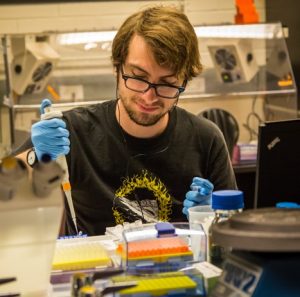
When Tyler Jorgenson graduated from Johns Hopkins with a bachelor’s degree in chemical and biomolecular engineering in 2015, he also took with him the unexpected experience of leading a research project and first-authoring a paper as an undergraduate.
“Being given the opportunity to lead a project in undergrad solidified my desire to go to graduate school and pursue a PhD,” Jorgenson says. “Already having a paper underneath my belt has given me confidence in my ability to write future papers.”
 In the lab, Jorgenson used DNA as a building block to create self-assembled functional biomaterials. Since current fabrication techniques can’t operate with ideal precision on the nanoscale, self-assembly techniques allow the creation of precise structures on the nanoscale that extend to the micron range. Jorgenson worked on developing new DNA origami structures that can template nanotubes to create networks, which interconnect for use in a variety of applications.
In the lab, Jorgenson used DNA as a building block to create self-assembled functional biomaterials. Since current fabrication techniques can’t operate with ideal precision on the nanoscale, self-assembly techniques allow the creation of precise structures on the nanoscale that extend to the micron range. Jorgenson worked on developing new DNA origami structures that can template nanotubes to create networks, which interconnect for use in a variety of applications.
After graduating a semester early in December 2015, Jorgenson stayed on in the lab for another semester as a research technologist. In 2016, he entered the PhD program in molecular engineering and science at the University of Washington, where he continues to focus on self-assembling biomaterials. Specifically, he works with peptides that can interface with inorganic materials to develop 2-D and 3-D bioelectronics, like photovoltaics and biosensors.
Jorgenson initially planned to work with non-biological systems, but says his experience at ChemBE with biomolecular engineering led him toward biomaterials instead. “I feel very well prepared for the graduate school classes I am taking, as well as very well prepared to conduct research,” he says.